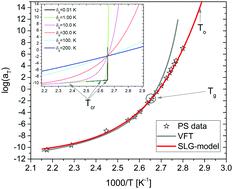当前位置:
X-MOL 学术
›
Soft Matter
›
论文详情
Our official English website, www.x-mol.net, welcomes your
feedback! (Note: you will need to create a separate account there.)
Exploring a unified description of the super-Arrhenius region above and below the glass transition temperature.
Soft Matter ( IF 2.9 ) Pub Date : 2020-07-03 , DOI: 10.1039/d0sm00539h Georgios Kritikos 1
Soft Matter ( IF 2.9 ) Pub Date : 2020-07-03 , DOI: 10.1039/d0sm00539h Georgios Kritikos 1
Affiliation

|
A new approach is presented in order to check whether the hypothesis of an Arrhenius component surviving in the α-relaxation region is consistent with experimental data. The temperature dependence of the dynamics in the whole glassy regime is described by an equation which assumes an Arrhenius component in the cooperative diffusion. Based on thermodynamic arguments, the dynamic heterogeneities close to the glass transition region are related to structural heterogeneities in a manner consistent with the idea of a sigmoidal shape in the cohesion energy. By doing so, a characteristic temperature which can be identified as the glass transition temperature (Tg) emerges, while an additional parameter for the extension of the super-Arrhenius region is introduced. In the analysis of experimental data, the activation energy parameter, determined from the temperature dependence of the β-relaxation, is fixed, and the relation between the experimental and the predicted glass transition temperature is examined. The results of this comparison support the idea that dynamics above and below Tg can be described in a unified manner. The proposed model is tested against experimental data of glass-forming liquids, polymers and polymer composites. In the latter systems, it is shown that the Arrhenius-like behavior characterizing the dynamics of the polymeric bound-layer can be accounted for by such an extension of the super-Arrhenius region.
中文翻译:

探索玻璃化转变温度以上和以下的超级阿雷尼乌斯区域的统一描述。
为了检查在α松弛区域中存活的阿累尼乌斯成分的假设是否与实验数据一致,提出了一种新方法。整个玻璃态中动力学的温度依赖性由方程式描述,该方程式假设协同扩散中的阿累尼乌斯成分。基于热力学论点,靠近玻璃化转变区域的动态异质性与结构异质性的关联方式与内聚能中的S形概念一致。这样,可以将特征温度确定为玻璃化转变温度(T g)出现,同时引入了用于扩展超阿伦尼乌斯区域的附加参数。在实验数据分析中,由β弛豫的温度依赖性确定的活化能参数是固定的,并检查了实验温度与预测的玻璃化转变温度之间的关系。该比较的结果支持这样的思想,即可以以统一的方式描述高于和低于T g的动力学。针对形成玻璃的液体,聚合物和聚合物复合材料的实验数据对提出的模型进行了测试。在后一系统中,表明了表征聚合物粘结层动力学的类阿里尼乌斯行为可以通过超级阿里尼乌斯区域的这种扩展来解释。
更新日期:2020-07-29
中文翻译:

探索玻璃化转变温度以上和以下的超级阿雷尼乌斯区域的统一描述。
为了检查在α松弛区域中存活的阿累尼乌斯成分的假设是否与实验数据一致,提出了一种新方法。整个玻璃态中动力学的温度依赖性由方程式描述,该方程式假设协同扩散中的阿累尼乌斯成分。基于热力学论点,靠近玻璃化转变区域的动态异质性与结构异质性的关联方式与内聚能中的S形概念一致。这样,可以将特征温度确定为玻璃化转变温度(T g)出现,同时引入了用于扩展超阿伦尼乌斯区域的附加参数。在实验数据分析中,由β弛豫的温度依赖性确定的活化能参数是固定的,并检查了实验温度与预测的玻璃化转变温度之间的关系。该比较的结果支持这样的思想,即可以以统一的方式描述高于和低于T g的动力学。针对形成玻璃的液体,聚合物和聚合物复合材料的实验数据对提出的模型进行了测试。在后一系统中,表明了表征聚合物粘结层动力学的类阿里尼乌斯行为可以通过超级阿里尼乌斯区域的这种扩展来解释。











































 京公网安备 11010802027423号
京公网安备 11010802027423号